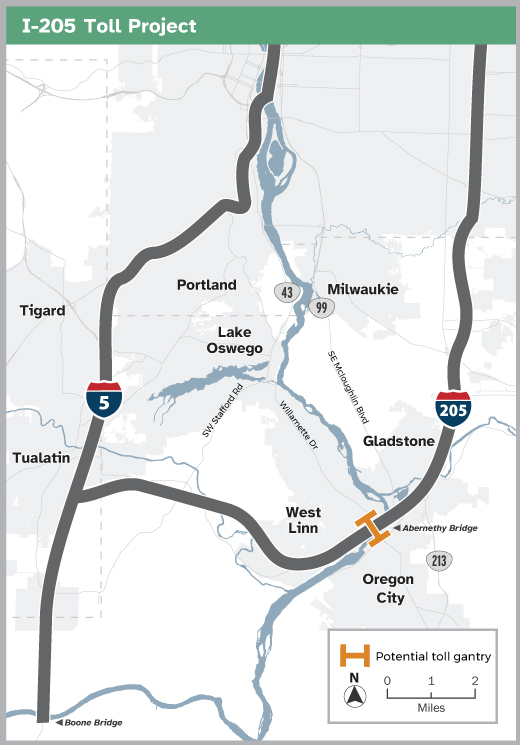March 11, 2024 Update: At the direction of Governor Kotek and the Oregon Transportation Commission, we have stopped work on the Regional Mobility Pricing Program and have indefinitely postponed our efforts for the I-205 Toll Project and the remainder of the Oregon Toll Program.
We are working with the Oregon Legislature as they identify sufficient and sustainable funding solutions to put Oregon’s transportation system on a solid foundation.
+++++++++++++++++++++++++++++++++++++++++++++++++++++++++++++++++
The I-205 Toll Project proposes tolling at the Abernethy Bridge, which spans the Willamette River between Oregon City and West Linn. Tolling will help repay a portion of the construction costs to make the I-205
Abernethy Bridge earthquake ready. Tolling will also help manage congestion and raise revenue for other roadway and multimodal projects.
Construction on the Abernethy Bridge is well underway and is scheduled for completion in 2025. When completed, the Abernethy Bridge will be the first earthquake-ready interstate structure across the Willamette River in the Portland area. Both the I-205 Toll Project and the Abernethy Bridge construction project are part of ODOT's
Urban Mobility Strategy, a cohesive approach to make everyday travel safer and more predictable in the Portland metro area.

Click on image to expand.
Current Status
In 2023, we published the I-205 Toll Project
Environmental Assessment in partnership with the Federal Highway Administration, followed by a 60-day public comment period. The Environmental Assessment described the effects of using variable rate tolls on the Abernethy Bridge and Tualatin River Bridges to raise revenue for the I-205 Improvements Project.
We received 2,800 public comments and identified 22 general themes that were frequently expressed. Examples include:
- Concerns about increased congestion on local streets and alternative routes to I-205 due to drivers avoiding tolls; this is known as diversion.
- A desire to understand why current taxes and other sources of funding aren't enough to fund the transportation system.
- Wanting clarity on how the toll revenue will be used now and in the future.
- Concerns about equity and the impact of tolling on community members.
Below are links to the public comments, a full engagement summary, and responses to frequently received comments:
Changes to the I-205 Toll Project scope
In May 2023, after we had completed the 2023 Environmental Assessment comment period, Gov. Tina Kotek directed ODOT to delay toll collection on I-205 and I-5 until 2026. With the delay in toll revenue and increasing construction costs, we reduced the scope of the I-205 Toll Project and some of the associated construction improvements on I-205 to better manage available funds. Now the I-205 Toll Project proposes tolling only at the Abernethy Bridge to help repay a portion of the Abernethy Bridge construction costs. These changes were outlined in the finance plan for all Urban Mobility Strategy projects.
Supplemental Environmental Assessment Summary
Due to the pause of the I205 Toll Project in March 2024, the Supplemental Environmental Assessment was not completed. The Supplemental Environmental Assessment would have been based on a revised Project Description and revised Purpose and Need statement.
The revised I-205 Toll Project Description stated:
The revised Project (Revised Build Alternative) is the implementation of tolling at the Abernethy Bridge. Under the Revised Build Alternative, drivers of vehicles on I-205 would be assessed a toll for crossing the Abernethy Bridge (between OR 43 and OR 99E). Toll gantries and supporting infrastructure would be located entirely within the existing I-205 right-of-way at the OR 43/I-205 interchange.
When we started the Supplemental Environmental Assessment, adjustments were made to our analysis to reflect some of the comments we received. This included using newer data when appropriate and potentially including local streets and intersections that we didn't previously analyze.
A congestion pricing toll system means tolls are higher during peak – or “congested" – periods to encourage drivers to consider changing their travel time, carpooling, taking the bus, or avoiding the trip altogether. According to the Federal Highway Administration, removing as little as 5 percent of cars from a busy road can improve traffic flow.
Congestion pricing gives people a choice for a faster highway trip when they need it – like when they need to get to work, make a medical appointment, or pick up their child from school or daycare.
On I-205, tolls would be all-electronic, meaning there would be no toll booths, and drivers would not stop and pay. An all-electronic collection system is convenient for travelers and allows vehicles to keep moving.
A transponder is a small tag or sticker placed on the windshield that is scanned by toll gantry. Toll gantries are overhead structures that read transponders and charge the account holder. If a vehicle doesn't have a transponder, a camera captures the car's license plate, and the registered owner is billed.
Click on image to expand.